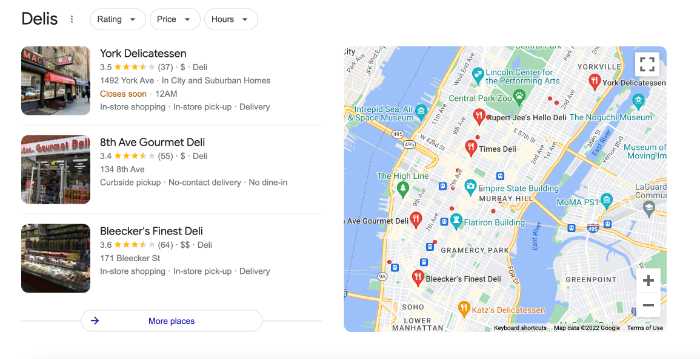Despite your best marketing efforts, the most valuable customer leads will never come from outbound ads or flashy campaigns.
The gold standard of marketing leads are generated from customer referrals. In a world where the average person is exposed to up to 10,000 ads per day, people are much more likely to purchase something recommended by another consumer. A full 92% of consumers will trust referrals from people they know, and are 4x more likely to purchase from the referred business.
In today’s digital landscape, online reviews function as a form of mass referrals. While they may not be written by a close friend, positive reviews signal to consumers that they can trust purchasing from a particular business.
The result? Google Business Profile reviews should become an essential part of any local business’s marketing strategy.
Google Business Profiles are designed to show potential customers everything they need to know about your business at-a-glance. One of the first things they’ll see is your star rating: the higher the star rating, the more positive customer reviews.
Seems straightforward, right? It is, mostly. There are a few key tips and strategies to consider when optimizing your star rating. Here’s our ultimate guide to Google’s star rating, where we’ll cover everything you need to know.
What are Google Star Ratings and how do they work?
Google star ratings are a simple representation of your business reviews as reflected in a 1-5 star rating system.
Google Business Star Ratings vs Seller Star Ratings
Google provides two different methods of star rating, based on your business structure and needs.
Google Business Profile Ratings
This is what typically comes to mind when business owners think of a star rating. These star ratings are provided to physical businesses that have created a profile on Google’s Business Directory. Star ratings are directly correlated with Google customer reviews (more on how that is calculated, later).
The star rating is placed alongside your business name in Google Map Pack listings.

Previously, Google required a set number of reviews before a business could be assigned a star rating. Today, businesses have a star rating with as little as one review.
Google Seller Reviews
If you’re an online retailer that doesn’t depend on a Google Business Profile listing, you can take advantage of Google seller reviews when advertising online.
Google has partnered with over 25 trusted review partners, from whom they source additional reviews from. When advertising with Google, online businesses can ask Google to aggregate a seller star rating based on data from review partners.
The result will look something like this:

Seller ratings are a closed review system: they aren’t influenced by your Google Business Profile.
While it’s useful to know the difference, most local businesses should focus primarily on a Google Business Profile star rating. For the remainder of this article, we’ll focus only on GBP star ratings.
How are Star Ratings Calculated?
It may seem like star ratings are created using a simple arithmetic average. Let’s say you have 100 4-star reviews and 100 5-star reviews. Your business should boast a 4.5 star rating, right? Not quite.
Google star ratings are calculated using a proprietary Google algorithm that also takes into account the quantity, quality, and recency of your reviews.
The algorithm also looks at other factors such as review diversity (multiple reviewers vs. one-time reviewer), personalization (a user’s past behavior on Google), site traffic, and more.
What Star Rating do I need?
Let’s be clear: you don’t need a 5-star rating to be successful. Only 4% of surveyed consumers said they would exclusively use a business that had 5 stars, and many even reported feeling “suspicious” of perfect 5-star ratings.
On the other end of the spectrum, only 3% of consumers would consider using a business that has 2 or fewer stars.
In general, a happy medium appears to be between 4.1-4.9 stars.
A SEMRush study found that higher star ratings correlate to more favorable Map Pack placement up to 4.1 stars. After 4.1 stars, other factors such as review volume take precedence.
Why shouldn’t I strive for 5 stars?
Fair question. Most studies indicate that a 5-star rating presents as less trustworthy than lower counterparts. A 4.5 star rating may be more valuable for a local business than a perfect 5 stars.
It may seem counterintuitive, but it makes sense when you think about how businesses can game Google’s review system.
As online reviews have become an integral part of our purchasing decisions over the past decade, bad actors have found a way to manipulate the system. False reviews have become an overwhelming problem, with 92% of consumers reporting they’ve seen fake reviews online recently.
Consumers know that it doesn’t take much for a company to purchase a few hundred 5-star reviews through a shady online vendor. A full 90% of Google users admit they are at least “a little suspicious” of fake reviews on Google.
This dramatically affects purchasing behavior: over half of consumers would not purchase a product or service if they expected fake reviews.
In many ways, a 5-star rating comes across as a bit too perfect. Real businesses have occasional flaws, irritated customers, or other areas that make a 5-star rating extremely difficult to achieve organically. In fact, 30% of consumers think that reviews are fake if there are no negative reviews. A less-than-perfect review score shows that you’re a real business!
How does Star Rating Impact Your Business?
Generally, a higher star rating correlates to better business: more customers, higher earnings, and improved SEO.
Better Business
A high star rating is one of the top 3 review factors that customers consider when deciding whether or not to frequent your business. An improved star rating directly correlates to an increased customer base.
Businesses with a 3.5-4.5 rating also statistically earn more than their counterparts outside of this bracket.
Improved SEO
Star rating plays a significant role in how a local business shows up online.
To be successful, Google Business Profiles must optimize for two search engines: Google Search and Google Maps. We’ll talk about the Map Pack today.
The Map Pack is a boxed area at the forefront of the SERP, showing the top 3-5 ranked business results in your area.
Here’s an example, look familiar?

These listings are generated from the Google My Business directory, rather than the typical web crawling that Google Search does. Those top 3 coveted Map Pack listings can make a critical difference for your business: on average, Map Pack listings receive 44% of total clicks per search. Divided three ways, a single map pack listing has a 15% chance of being clicked with each search.
If getting on the Map Pack is the goal, what role do star ratings play here? A study found that star ratings can determine 13% of your listing’s chances to get placed in the Map Pack.
How to Get the Most Out of Your Star Rating
Ok, let’s say you’ve worked hard to achieve an ideal 4.1-4.9 star rating on your Google Business profile. What now? How can you effectively market this star rating to increase business?
Include on Your Website
Without a doubt, one of the most impactful things you can do is display a star rating on your marketing website. Using plug-and-play tools like Trustmetrics, business owners can add a widget to their marketing website in minutes, looking something like this:

Because the widget is updated in real-time, there’s no need to constantly adjust and re-upload the ratings badge if your score changes.
Adding a star rating to your website does the following:
- Builds Brand Trust: A star rating shows visible social proof that customers like your business and the services that it provides. Google’s household name adds credibility to your rating.
- Increases Conversion Rate: 72% percent of buyers reported taking purchasing action only after reading a positive review online. A high star rating, signaling numerous positive reviews, can lead potential customers down the sales funnel and encourage them to purchase from you.
Display At Your Business & in Promotional Materials
Don’t neglect the power of in-person advertising. A positive Google star rating is a clear indication to customers that they should consider doing business with you. Place a sticker on your window, add a star rating to your email signature, or create a ratings badge to include on flyers.
Strategies for Increasing Your Star Rating
Increase Number of Positive Reviews
If your star rating is 4.1 or below, prioritize improving your star rating before leveraging it in marketing efforts. The most effective way to improve your star rating, of course, is by increasing your number of positive customer reviews.
We’ve written a guide of 11 strategies for increasing your pool of customer reviews. Here are a few to get you started:
- Train employees to ask for reviews in person. Statistically, customers are more likely to write reviews if they are simply asked to do so. If you know that a customer has had a positive experience with your business, ask them to leave a review!
- Note that it is against Google’s Terms of Service to offer monetary incentives or selectively solicit positive reviews. Don’t bribe customers or deter specific customers from reviewing your business
- Use Social Media. Create posts showcasing your best reviews and encouraging other customers to share their experiences. Over 3.96 billion consumers regularly use social media, making it a highly effective way to reach your target market with limited budget.
- Create a Custom Link QR code. A recent study reported a 94% increase in QR code interaction growth from 2020 to 2022. Popularized by the pandemic, QR codes are a simple way of directing customers to a link. Rather than typing out a long URL, reviewers only need to point their phone camera and the QR code will automatically direct them to a custom review page.
- If you haven’t yet created a custom review link for your business, now is the time.
Look for Areas of Improvement
While collecting more positive reviews boosts your star rating, a poor star rating is generally a symptom of larger problems. Take a step back and carefully comb through your reviews: are there tangible changes you can make to improve customer experience? If multiple reviewers complain about the cleanliness of your bathroom or the lack of vegetarian options, now’s the time to change course and make those small improvements to your business.
Get to the root of the issue and use negative reviews as a valuable tool to identify where to improve.
Once you’ve made the necessary alterations, customers will be much more willing to leave a positive review to make up the difference. In fact, 73% of surveyed consumers reported that they would leave a positive review for a business if they thought that their star rating was undeservedly low.
Respond to Negative Reviews
Don’t just ignore negative reviews: respond to them promptly! Doing so signals to potential customers that you care about their experience and helps repair the relationship with the reviewer.
When responding, be sure to acknowledge their criticisms and avoid defensive language. If the situation calls for it, offer some form of remediation (ex. Did your restaurant forget an item in a to-go order? Offer a gift card to be used on future purchases).
While it’s not common, there’s always the chance that the reviewer will see your response and edit their Google review accordingly.
Every customer counts. Negative reviews are a valuable tool to learn from and interact with customers, building a relationship with them in the process.
***
Google Business Profile’s star rating is one of the most important online metrics to consider when marketing your local business. Strive to stay within a 4.1-4.9 star rating, a bracket that appears genuine, trustworthy, and high enough to rank in Google’s Map pack listing.
If your star rating isn’t quite where you’d like it to be, focus on Google review management first. Use tools like Trustmetrics to collect new reviews from customers, respond to negative reviews, and monitor the health of your rating from a single dashboard.


